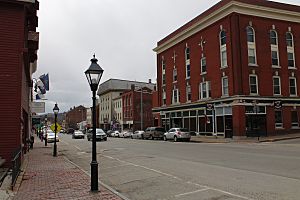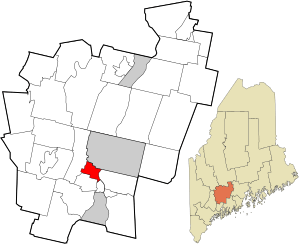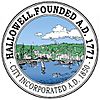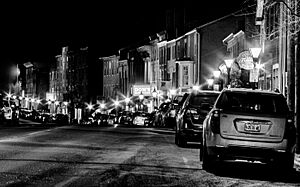Hallowell, Maine facts for kids
Quick facts for kids
Hallowell, Maine
|
||
|---|---|---|
|
City
|
||

A view of Water Street (US 201) in the city's historic heart.
|
||
|
||

Location in Kennebec County and the state of Maine.
|
||
| Country | United States | |
| State | Maine | |
| County | Kennebec | |
| Incorporated | 1771 | |
| Village | Granite Hill | |
| Area | ||
| • Total | 6.08 sq mi (15.76 km2) | |
| • Land | 5.86 sq mi (15.19 km2) | |
| • Water | 0.22 sq mi (0.57 km2) | |
| Elevation | 39 ft (12 m) | |
| Population
(2020)
|
||
| • Total | 2,570 | |
| • Density | 438.27/sq mi (169.22/km2) | |
| Time zone | UTC−5 (Eastern (EST)) | |
| • Summer (DST) | UTC−4 (EDT) | |
| ZIP code |
04347
|
|
| Area code(s) | 207 | |
| FIPS code | 23-30550 | |
| GNIS feature ID | 0567519 | |
| Website | www.hallowell.govoffice.com | |
Hallowell is a small city in Kennebec County, Maine, United States. In 2020, about 2,570 people lived there. Hallowell is well-known for its interesting culture and beautiful old buildings. It's a popular spot for tourists and is part of the larger Augusta area.
Contents
History of Hallowell
Hallowell is named after Benjamin Hallowell. He was a merchant from Boston and owned a lot of land in the area. This land was originally given to the Plymouth Company by the British monarchy in the 1620s.
Early Settlers
The first European settler was Deacon Pease Clark. He came with his wife and son Peter from Attleborough, Massachusetts, in 1762. The story says they landed on the west side of the Kennebec River. They even slept in their overturned cart! The Clark family grew corn and other crops on their land.
Growth and Industry
In 1797, the city of Augusta separated from Hallowell. The part of Hallowell that is the city today was then called "The Hook." By 1830, Hallowell was a busy place. It had 71 stores along Water Street, which was more than Augusta at the time.
Many businesses thrived here. These included cutting down trees (logging), trading goods, publishing books, and shipbuilding. About 50 ships were launched from Hallowell's docks between 1783 and 1901. They could sail all the way to the Atlantic Ocean. The city also had mills for grinding grain and sawing wood.
Granite and Ice Industries
Around 1815, people started digging for granite nearby. This began a new industry that supported Hallowell until 1908. Granite was used for building, but later cement became more popular.
In 1826, the ice industry started. Thousands of people worked in this business for the next 75 years. Large blocks of ice were cut from the river. They were loaded onto ships called schooners. These ships delivered the ice to places like Cuba and the West Indies. Other products from Hallowell, like sandpaper and shoes, were also sent out by river or by train after 1857.
Challenges and Changes
The Kennebec River was important for Hallowell's growth. However, it also caused problems. Spring floods often stopped businesses and scared shopkeepers. Sometimes, people and children playing on the ice in winter would fall through.
In 1816, there was "the Year Without a Summer." Many crops were damaged or destroyed in New England, including Hallowell. Farmers had to sell their remaining crops for much higher prices.
In 1875, the state opened the Maine Industrial School for Girls in Hallowell. This was the first school in Maine for girls who needed a fresh start. It operated until the 1970s.
Geography
Hallowell is located at 44°17′12″N 69°47′52″W / 44.28667°N 69.79778°W. The city covers about 6.09 square miles (15.76 square kilometers). Most of this is land, with a small amount of water. Vaughn Brook flows through Hallowell, and the city is next to the Kennebec River.
Neighboring Towns
Hallowell shares borders with several other towns:
- Farmingdale to the south
- Manchester to the west
- Augusta to the north
- Chelsea across the Kennebec River to the east
Climate
Hallowell has a humid continental climate. This means it has big changes in temperature throughout the year. Summers are warm to hot and often humid. Winters are cold, and sometimes very cold.
Culture
Hallowell has a few fun nicknames, like "The Little Easy" or "New Orleans on the Kennebec." It's also known as "Maine's Antique Riverport" because of its history.
Events and Arts
Since 1968, Hallowell has hosted "Old Hallowell Day." This is an annual celebration held in July. It includes a parade, fireworks, and live performances.
The city is also home to Gaslight Theater. This is one of Maine's oldest community theater groups. Hallowell has been a center for the arts in central Maine for many years. You can find art galleries, studios, and festivals here.
Food and Fun
Hallowell is also known for its many bars, taverns, and restaurants. The downtown area has a lot of places to eat and drink.
The Hallowell Farmers' Market happens every Saturday morning at Stevens Commons. It's a great place to find fresh, local products.
Population Information
| Historical population | |||
|---|---|---|---|
| Census | Pop. | %± | |
| 1790 | 1,194 | — | |
| 1800 | 1,364 | 14.2% | |
| 1810 | 2,068 | 51.6% | |
| 1820 | 2,919 | 41.2% | |
| 1830 | 3,961 | 35.7% | |
| 1840 | 4,654 | 17.5% | |
| 1850 | 4,769 | 2.5% | |
| 1860 | 2,435 | −48.9% | |
| 1870 | 3,007 | 23.5% | |
| 1880 | 3,154 | 4.9% | |
| 1890 | 3,181 | 0.9% | |
| 1900 | 2,714 | −14.7% | |
| 1910 | 2,864 | 5.5% | |
| 1920 | 2,764 | −3.5% | |
| 1930 | 2,675 | −3.2% | |
| 1940 | 2,906 | 8.6% | |
| 1950 | 3,404 | 17.1% | |
| 1960 | 3,169 | −6.9% | |
| 1970 | 2,814 | −11.2% | |
| 1980 | 2,502 | −11.1% | |
| 1990 | 2,534 | 1.3% | |
| 2000 | 2,467 | −2.6% | |
| 2010 | 2,381 | −3.5% | |
| 2020 | 2,570 | 7.9% | |
| U.S. Decennial Census | |||
In 2010, Hallowell had 2,381 people living in 1,193 households. The average age of people in the city was 50.5 years old. About 14% of the residents were under 18 years old.
Education
Hallowell is part of the Hall-Dale School System. This system also includes the nearby town of Farmingdale. They are part of a larger school district called Kennebec Intra-District Schools (KIDS) Regional School Unit 2. This district also includes the towns of Dresden and Monmouth.
Hallowell and Farmingdale have three schools:
- Hall-Dale Elementary School (Pre-K to 5th grade) is in Hallowell.
- Hall-Dale Middle School (6th to 8th grade) is in Farmingdale.
- Hall-Dale High School (9th to 12th grade) is also in Farmingdale.
Architecture
One interesting building in Hallowell is The Emporium at 154 Water Street. It was built in the early 1800s. Around 1870, it got a special cast-iron front, giving it a fancy Victorian look. This building is so important that it's listed in the Historic American Buildings Survey.
Places to Visit
Here are some interesting places in Hallowell:
- Elm Hill Farm
- Gaslight Theater
- Harlow Gallery (home of the Kennebec Valley Art Association)
- Hubbard Free Library
- Kennebec Ice Arena
- Kennebec Lodge No. 5 A.F. & A.M. (a Masonic lodge started by Paul Revere in 1796)
- Powder House Lot
- St. Matthew's Episcopal Church
- Vaughan Homestead
Notable people
Images for kids
See also
 In Spanish: Hallowell para niños
In Spanish: Hallowell para niños






